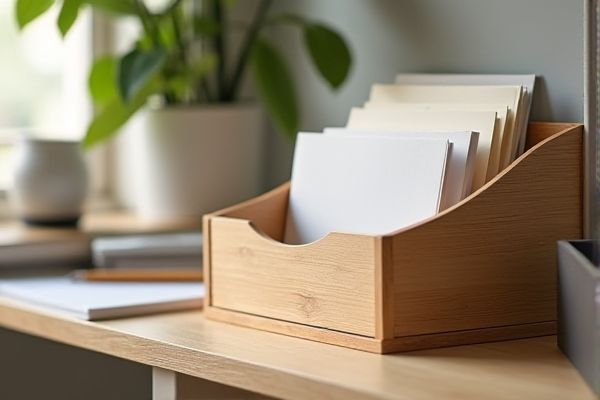
A letter tray organizes incoming and outgoing letters in a stackable format, making it ideal for managing your daily correspondence efficiently. Exploring the differences between a letter tray and a mail sorter can help you choose the best option for keeping your workspace tidy--read on to find out more.
Table of Comparison
| Feature | Letter Tray | Mail Sorter |
|---|---|---|
| Purpose | Organizes loose letters or documents in horizontal trays | Sorts mail into multiple compartments or slots by category |
| Design | Stackable trays, usually open top, horizontal design | Vertical or grid layout with multiple labeled sections |
| Capacity | Holds a moderate volume of papers per tray | Accommodates large volumes of sorted mail |
| Usage | Ideal for individual or small office use | Best for departments or offices handling diverse mail types |
| Sorting Method | Manual, by placing papers in trays | Predefined categories for quick access and distribution |
| Material | Plastic, metal, or wood | Plastic, metal, wood, or mesh |
| Cost | Generally lower cost | Moderate to higher cost due to complexity |
Understanding Letter Trays and Mail Sorters
Letter trays are compact organizing tools designed to hold incoming or outgoing documents in a neat stack, ideal for managing your desk space efficiently. Mail sorters, often featuring multiple compartments, enable systematic categorization and distribution of mail based on recipient or priority, streamlining office workflow. Choosing between these depends on your volume of mail and organizational needs, with letter trays suited for general document holding and mail sorters tailored for detailed mail sorting tasks.
Design Differences Between Letter Trays and Mail Sorters
Letter trays typically feature a simple, stackable design with open compartments for easy access to documents, making them ideal for organizing loose papers or incoming mail on a desktop. Mail sorters, on the other hand, often have multiple labeled slots arranged vertically or horizontally to categorize mail by recipient or type, enhancing sorting efficiency in offices or mailrooms. Your choice between the two should consider the volume of mail and the level of organization required for your workspace.
Capacity and Organization Features
Letter trays typically offer higher capacity, accommodating large stacks of documents due to their open, tiered design, making them ideal for quickly sorting incoming mail and papers. Mail sorters provide enhanced organization features with multiple labeled compartments, allowing you to categorize letters, bills, and packages efficiently for specific recipients or departments. Your choice depends on whether you prioritize bulk storage with easy access or detailed separation for streamlined workflow management.
Space Efficiency in Office Environments
A letter tray offers compact stacking options that maximize vertical space, making it ideal for small desks or crowded offices. Mail sorters typically provide multiple compartments for categorizing documents, but they often require a larger footprint, which can reduce overall workspace efficiency. You can enhance your office organization by selecting a letter tray when conserving desk space is a priority.
Materials and Durability Comparison
Letter trays are commonly made from plastic, metal, or wood, offering various levels of durability depending on the material chosen. Mail sorters often feature sturdier construction with metal frames or heavy-duty plastic, designed to withstand frequent handling and heavier loads. Metal mail sorters provide superior durability and longevity compared to standard plastic letter trays, making them ideal for high-traffic office environments.
Aesthetic Appeal and Office Decor
Letter trays offer a sleek and minimalist design, enhancing your office decor with a modern touch while keeping documents neatly stacked. Mail sorters provide a more structured and practical appearance, adding an organized and professional vibe to your workspace with multiple compartments for easy sorting. Choosing between them depends on your preference for aesthetic appeal or functional organization in your office environment.
Ease of Access and Usability
Letter trays offer easy access with their open design, allowing users to quickly slide documents in and out without obstruction. Mail sorters provide structured compartments that enhance organization but may require more time to locate specific items due to their segmented layout. For everyday usability, letter trays are ideal for fast sorting, while mail sorters excel in environments demanding detailed categorization.
Suitability for Home vs. Business Use
Letter trays are ideal for home environments, providing a simple and compact solution to organize incoming and outgoing correspondence with limited space. Mail sorters are better suited for business use, offering multiple compartments that allow efficient categorization and distribution of large volumes of mail across departments or employees. Choose a letter tray if your goal is to maintain neat personal mail organization, while a mail sorter supports higher demand and structured workflow in office settings.
Price Range and Value for Money
Letter trays typically range from $10 to $30, offering an affordable solution for organizing documents with basic functionality and durable materials. Mail sorters, priced between $20 and $60, provide enhanced compartments and categories for better mail management, delivering greater value for those handling higher volumes or diverse correspondence. Investing in a mail sorter often yields improved organization efficiency despite the higher upfront cost, making it cost-effective for frequent users.
Choosing the Right Solution for Your Needs
Choosing between a letter tray and a mail sorter depends on the volume and organization style of your incoming correspondence. Letter trays are ideal for stacking documents in a simple, accessible manner, optimizing desk space for lighter mail flows. Mail sorters offer multiple compartments for categorizing mail by recipient or priority, providing a tailored system that enhances your office efficiency and ensures timely handling of important items.
 homyna.com
homyna.com